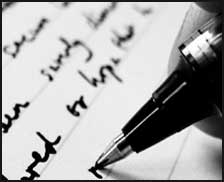Section 13: Plan Your Essay and Start Writing
Skills Focus: Exposition Framing evidenceHW, Part 1: Essay Plan Draw up a provisional plan for your essay.
- Review the prompt for essay 2, and decide which work you’d like to write about
- Spend time reviewing that work, rereading passages or rewatching scenes or episodes
- Within the work, choose a focus—specific passages or scenes you find thought-provoking, and concrete details you envision discussing in your essay
- In selecting passages or scenes to discuss, look for puzzling or anomalous elements, moments of surprise, contradictions, or easily overlooked but significant details, since these will be passages or scenes whose meaning isn’t straightforward or obvious.
- In other words, choose passages or scenes whose interpretation is arguable
- Choose passages/details that in some way seem to go together—that form part of a pattern of meaning
- In selecting passages or scenes to discuss, look for puzzling or anomalous elements, moments of surprise, contradictions, or easily overlooked but significant details, since these will be passages or scenes whose meaning isn’t straightforward or obvious.
- Draft a preliminary plan for your essay
- Note the work you plan to write about
- Identify specific passages or scenes you’re thinking of discussing
- Sketch out the argument you expect to develop in your essay.
- Identify a few concrete details you expect to focus your analysis on
- Explain why these passages or scenes are surprising or puzzling, why they require interpretation, or why they’re more significant than they might initially appear to be
- Pose the question these details raise for you—the question your argument will seek to answer
- State your current thought about what the pattern means or what idea it conveys—that is, your provisional thesis, your answer to the question you posed
- Email me your essay plan
HW, part 3: Analytical Paragraph Write a body ¶ for your essay—a paragraph that presents and analyzes evidence
- Open your paragraph with a strong analytical claim about the particular scene or passage you’re analyzing in this ¶
- Present the passage or scene you’re going to analyze
- Describe it in vivid but neutral terms, so that readers feel able to see and assess the evidence for themselves
- Briefly orient your audience by explaining how the scene fits into the larger piece or by identifying the characters involved
- For instance, is it near the beginning? Near the end? What leads up to the scene you’re discussing—what happens immediately prior to it? What happens immediately after this scene? Who are the characters—relatives? friends? rivals?
- If you’re writing about a scene in DWP, identify the episode in which the scene occurs, perhaps briefly describe that episode, and note the time stamp
- If you’re writing about “Twin Study,” consider quoting part of the passage you’re going to analyze
- If you’re writing about a scene from Pygmalion or DWP, you may, if appropriate, quote lines of dialogue. In addition consider visual details or sound elements that contribute to the scene, such as
- Movement of the camera—how it frames the scene and what it appears to focus on (angle of view, close-ups, long shots)
- Lighting
- Music or sound effects
- Setting
- Analyze the passage or scene
- Connect the evidence you’re presenting to your interpretive claim about what the evidence means
- In addition to stating what you think the details convey, explain why you interpret the passage or scene this way.
- Aim to share your thought process—the reasoning by which you arrive at your interpretation
- Post your analytical paragraph to the student writing section of the course website.
